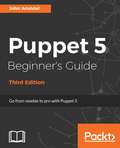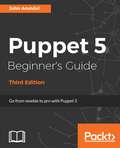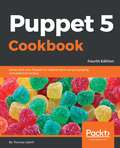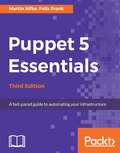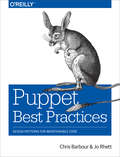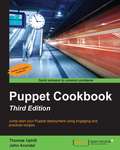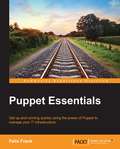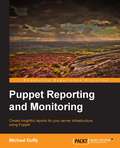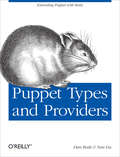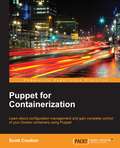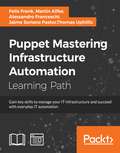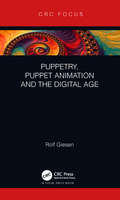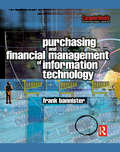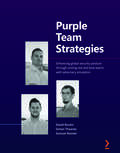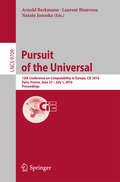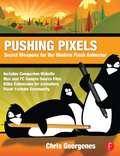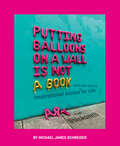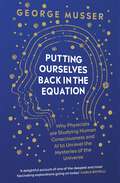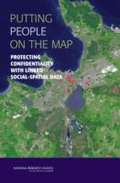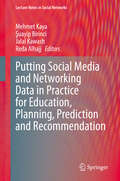- Table View
- List View
Puppet 4.10 Beginner's Guide - Second Edition
by John ArundelPuppet is great for developers, system administrators, IT professionals, and anyone laying the foundation for DevOps practices – this comprehensive guide will get you up to speed, all the way from installation to automation to the latest features of Puppet 4.10. About This Book • Develop skills to run Puppet 4.10 on single or multiple servers without hiccups • Use Puppet to spin up and manage cloud resources such as Amazon EC2 instances • Take full advantage of the powerful new features of Puppet 4.10, including loops, data types, structured facts, R10K module management, control repos, and EPP templates Who This Book Is For Puppet Beginner's Guide, Second Edition is designed for those who are new to Puppet, including system administrators and developers who are looking to manage computer server systems for configuration management. No prior programming or system administration experience is assumed. What You Will Learn • Covers the latest Puppet 4.10 release • Install and set up Puppet and discover the latest and most advanced features • Configure, build, and run containers in production using Puppet's industry-leading Docker support • Deploy configuration files and templates at super-fast speeds and manage user accounts and access control • Automate your IT infrastructure • Use the latest features in Puppet 4 onward and its official modules • Manage clouds, containers, and orchestration • Get to know the best practices to make Puppet more reliable and increase its performance In Detail Puppet 4.10 Beginner's Guide, Second Edition, gets you up and running with the very latest features of Puppet 4.10, including Docker containers, Hiera data, and Amazon AWS cloud orchestration. Go from beginner to confident Puppet user with a series of clear, practical examples to help you manage every aspect of your server setup. Whether you're a developer, a system administrator, or you are simply curious about Puppet, you'll learn Puppet skills that you can put into practice right away. With practical steps giving you the key concepts you need, this book teaches you how to install packages and config files, create users, set up scheduled jobs, provision cloud instances, build containers, and so much more. Every example in this book deals with something real and practical that you're likely to need in your work, and you'll see the complete Puppet code that makes it happen, along with step-by-step instructions for what to type and what output you'll see. All the examples are available in a GitHub repo for you to download and adapt for your own server setup. Style and approach This tutorial is packed with quick step-by-step instructions that are immediately applicable for beginners. This is an easy-to-read guide, to learn Puppet from scratch, that explains simply and clearly all you need to know to use this essential IT power tool, while applying these solutions to real-world scenarios.
Puppet 5 Beginner's Guide - Third Edition
by John ArundelPuppet 5 Beginner's Guide, Third Edition is a practical guide that gets you up and running with the very latest features of Puppet 5. About This Book • Develop skills to run Puppet 5 on single or multiple servers without hiccups • Use Puppet to create and manage cloud resources such as Amazon EC2 instances • Take full advantage of powerful new features of Puppet including loops, data types, Hiera integration, and container management Who This Book Is For Puppet 5 Beginner's Guide, Third Edition is designed for those who are new to Puppet, including system administrators and developers who are looking to manage computer server systems for configuration management. No prior programming or system administration experience is assumed. What You Will Learn • Understand the latest Puppet 5 features • Install and set up Puppet and discover the latest and most advanced features • Configure, build, and run containers in production using Puppet's industry-leading Docker support • Deploy configuration files and templates at super-fast speeds and manage user accounts and access control • Automate your IT infrastructure • Use the latest features in Puppet 5 onward and its official modules • Manage clouds, containers, and orchestration • Get to know the best practices to make Puppet more reliable and increase its performance In Detail Puppet 5 Beginner's Guide, Third Edition gets you up and running with the very latest features of Puppet 5, including Docker containers, Hiera data, and Amazon AWS cloud orchestration. Go from beginner to confident Puppet user with a series of clear, practical examples to help you manage every aspect of your server setup. Whether you're a developer, a system administrator, or you are simply curious about Puppet, you'll learn Puppet skills that you can put into practice right away. With practical steps giving you the key concepts you need, this book teaches you how to install packages and config files, create users, set up scheduled jobs, provision cloud instances, build containers, and so much more. Every example in this book deals with something real and practical that you're likely to need in your work, and you'll see the complete Puppet code that makes it happen, along with step-by-step instructions for what to type and what output you'll see. All the examples are available in a GitHub repo for you to download and adapt for your own server setup. Style and approach This tutorial is packed with quick step-by-step instructions that are immediately applicable for beginners. This is an easy-to-read guide, to learn Puppet from scratch, that explains simply and clearly all you need to know to use this essential IT power tool, while applying these solutions to real-world scenarios.
Puppet 5 Beginner's Guide Third Edition
by John ArundelPuppet 5 Beginner's Guide, Third Edition is a practical guide that gets you up and running with the very latest features of Puppet 5.About This Book* Develop skills to run Puppet 5 on single or multiple servers without hiccups* Use Puppet to create and manage cloud resources such as Amazon EC2 instances* Take full advantage of powerful new features of Puppet including loops, data types, Hiera integration, and container managementWho This Book Is ForPuppet 5 Beginner's Guide, Third Edition is designed for those who are new to Puppet, including system administrators and developers who are looking to manage computer server systems for configuration management. No prior programming or system administration experience is assumed.What You Will Learn* Understand the latest Puppet 5 features* Install and set up Puppet and discover the latest and most advanced features* Configure, build, and run containers in production using Puppet's industry-leading Docker support* Deploy configuration files and templates at super-fast speeds and manage user accounts and access control* Automate your IT infrastructure* Use the latest features in Puppet 5 onward and its official modules* Manage clouds, containers, and orchestration* Get to know the best practices to make Puppet more reliable and increase its performanceIn DetailPuppet 5 Beginner's Guide, Third Edition gets you up and running with the very latest features of Puppet 5, including Docker containers, Hiera data, and Amazon AWS cloud orchestration. Go from beginner to confident Puppet user with a series of clear, practical examples to help you manage every aspect of your server setup.Whether you're a developer, a system administrator, or you are simply curious about Puppet, you'll learn Puppet skills that you can put into practice right away. With practical steps giving you the key concepts you need, this book teaches you how to install packages and config files, create users, set up scheduled jobs, provision cloud instances, build containers, and so much more.Every example in this book deals with something real and practical that you're likely to need in your work, and you'll see the complete Puppet code that makes it happen, along with step-by-step instructions for what to type and what output you'll see. All the examples are available in a GitHub repo for you to download and adapt for your own server setup.Style and approachThis tutorial is packed with quick step-by-step instructions that are immediately applicable for beginners. This is an easy-to-read guide, to learn Puppet from scratch, that explains simply and clearly all you need to know to use this essential IT power tool, while applying these solutions to real-world scenarios.
Puppet 5 Cookbook: Jump start your Puppet 5.x deployment using engaging and practical recipes, 4th Edition
by Thomas UphillWrite custom plugins for Puppet, including facts, providers, and functionsKey FeaturesGrasp recipes that work with centralized and decentralized deploymentsExplore language differences and enhancements anticipated in Puppet version 5.xGain expert understanding of Puppet's latest and most advanced featuresBook DescriptionPuppet is a configuration management system that automates all your IT configurations, giving you control of managing each node. Puppet 5 Cookbook will take you through Puppet's latest and most advanced features, including Docker containers, Hiera, and AWS Cloud Orchestration. Updated with the latest advancements and best practices, this book delves into various aspects of writing good Puppet code, which includes using Puppet community style, checking your manifests with puppet-lint, and learning community best practices with an emphasis on real-world implementation.You will learn to set up, install, and create your first manifests with version control, and also learn about various sysadmin tasks, including managing configuration files, using Augeas, and generating files from snippets and templates. As the book progresses, you'll explore virtual resources and use Puppet's resource scheduling and auditing features. In the concluding chapters, you'll walk through managing applications and writing your own resource types, providers, and external node classifiers.By the end of this book, you will have learned to report, log, and debug your system.What you will learnDiscover the latest and most advanced features of PuppetMaster techniques to deal with centralized and decentralized Puppet deploymentsUse exported resources and forge modules to configure and deploy applicationsCreate efficient manifests to streamline your deploymentsAutomate deployment of puppet environment using git-hooksDeploy AWS instances and Docker containers with PuppetMake Puppet reliable, performant, and scalableWho this book is forPuppet 5 Cookbook is for anyone who builds and administers servers, especially in a web operations context. You’ll need some experience of Linux systems administration, including familiarity with the command line, filesystem, and text editing. No prior programming experience is required.
Puppet 5 Essentials - Third Edition
by Felix Frank Martin AlfkeA Guide to managing servers and automation About This Book • Breeze through Puppet's key features and performance improvements to bring real advantages to your IT infrastructure • Discover Puppet best practices to help you avoid common mistakes and pitfalls • Examples to help you get to grips with Puppet and succeed with everyday IT automation Who This Book Is For This book targets experienced IT professionals and new Puppet uses, who will learn all they need to know to go from installation to advanced automation. Get a rapid introduction to the essential topics and learn how to build best practices for advanced automation with Puppet. What You Will Learn • Understand declarative configuration management • Make use of GIT-based deployment workflows • Extend Factor with secure elements • Create modular and reusable Puppet code • Extend your code base with publicly available Puppet modules • Separate logic from data by using Hiera • Understand and develop Puppet Roles and Profiles In Detail Puppet is a configuration management tool that allows you to automate all your IT configurations, giving you control over what you do to each Puppet Agent in a network, and when and how you do it. In this age of digital delivery and ubiquitous Internet presence, it's becoming increasingly important to implement scaleable and portable solutions, not only in terms of software, but also the system that runs it. This book gets you started quickly with Puppet and its tools in the right way. It highlights improvements in Puppet and provides solutions for upgrading. It starts with a quick introduction to Puppet in order to quickly get your IT automation platform in place. Then you learn about the Puppet Agent and its installation and configuration along with Puppet Server and its scaling options. The book adopts an innovative structure and approach, and Puppet is explained with flexible use cases that empower you to manage complex infrastructures easily. Finally, the book will take readers through Puppet and its companion tools such as Facter, Hiera, and R10k and how to make use of tool chains. Style and approach This book aims to impart all the knowledge required to tap into not only the basics of Puppet, but also its core. The basic ideas and principles of Puppet-based designs are explored and explained. Sophisticated tools are presented to enable you to use Puppet efficiently and productively.
Puppet Best Practices: Design Patterns for Maintainable Code
by Jo Rhett Chris BarbourIf you maintain or plan to build Puppet infrastructure, this practical guide will take you a critical step further with best practices for managing the task successfully. Authors Chris Barbour and Jo Rhett present best-in-class design patterns for deploying Puppet environments and discuss the impact of each. The conceptual designs and implementation patterns in this book will help you create solutions that are easy to extend, maintain, and support.Essential for companies upgrading their Puppet deployments, this book teaches you powerful new features and implementation models that weren’t available in the older versions. DevOps engineers will learn how best to deploy Puppet with long-term maintenance and future growth in mind.Explore Puppet’s design philosophy and data structuresGet best practices for using Puppet’s declarative languageExamine Puppet resources in depth—the building blocks of state managementLearn to model and describe business and site-specific logic in PuppetSee best-in-class models for multitiered data management with HieraExplore available options and community experience for node classificationUtilize r10k to simplify and accelerate Puppet change managementReview the cost benefits of creating your own extensions to PuppetGet detailed advice for extending Puppet in a maintainable manner
Puppet Cookbook - Third Edition
by John Arundel Thomas UphillThis book is for anyone who builds and administers servers, especially in a web operations context. It requires some experience of Linux systems administration, including familiarity with the command line, file system, and text editing. No programming experience is required.
Puppet Cookbook Third Edition
by John Arundel Thomas UphillPuppet is a configuration management system that automates all your IT configurations, giving you control of what you do to each node, when you do it, and how you do it. Puppet Cookbook Third Edition takes the reader from a basic knowledge of Puppet to a complete and expert understanding of Puppet's latest and most advanced features. Updated with the latest advancements and best practices, it gives you a clear view on how to "connect the dots" and expands your knowledge to successfully use and extend Puppet. This book delves into various aspects of writing good Puppet code, which includes using Puppet community style, checking your manifests with puppet-lint, and learning community best practices, with an emphasis on real-world implementation.
Puppet Essentials
by Felix FrankIf you're an experienced IT professional or a new Puppet user, Puppet Essentials provides you with all you need to know to go from installation to advanced automation in no time at all. Experience with system operations and server management as well as the Ruby language, is helpful to get the most out of this book.
Puppet Reporting and Monitoring
by Michael DuffyAn easy to follow guide with extensive examples to explain Puppet's reporting capabilities to facilitate effective implementation of Puppet in the real world as a reporting tool.If you are a Puppet developer or a system administrator using Puppet, and you want to extend your expertise to manage and optimize your server resources, then this book is for you.
Puppet Types and Providers: Extending Puppet with Ruby
by Nan Liu Dan BodePuppet’s true power exists in the simple resource model it uses to manage the state of complex operating systems. This concise guide shows you how to extend that model and implement custom functionality on top of Puppet by working with the type and provider APIs.Two experts from Puppet Labs explain the concepts behind these APIs, and provide instructions and examples to help you write your own fully functional types and providers. You’ll also delve into Puppet’s source code to get a better understanding of how types and providers are implemented internally. If you’re familiar with basic Puppet concepts, you’re ready to get started.Learn the fundamental concepts behind resources, and become familiar with the structure of Puppet’s Resource ModelDiscover how the type API is used to create new resource types that Puppet can manageUnderstand how providers interact with the system to achieve the desired state of a declared resourceExplore advanced features to get a more complete understanding of how Puppet worksSimplify the troubleshooting process when developing types and providers
Puppet for Containerization
by Scott CoultonThis book is designed for system administrators who are looking to explore containerization. Intermediate experience and expertise with Puppet is presumed.
Puppet: Mastering Infrastructure Automation
by Alessandro Franceschi Felix Frank Martin Alfke Jaime Soriano Pastor Thomas UphillisStart pulling the strings of your IT infrastructure effectively with Puppet – learn how to configure, customize and manage your systems more intelligently in an enterprise deployment. About This Book • Step-by-step instructions to jump start your Puppet deployment and automate your IT configurations • Design, implement, and deploy Puppet in your infrastructure and tackle everyday IT infrastructure challenges • Gain expert understanding of Puppet's latest and most advanced features Who This Book Is For If you're an experienced IT professional and a new Puppet user, this course will provide you with all you need to know to go from installation to advanced automation. What You Will Learn • Write and employ individual Puppet manifests • Understand how Puppet implements system abstraction • Use Puppet to manage network, cloud, and virtualization devices • Manage and test the Puppet code workflow • Tweak, hack, and adapt the Puppet extension points • Use exported resources to orchestrate change between machines • Debug a puppetserver using Java techniques In Detail Puppet is a configuration management tool that allows you to automate all your IT configurations, giving you control. It was written for and by system administrators to manage large numbers of systems efficiently and prevent configuration drifts. Puppet gives you control of what you do to each node, when you do it, and how you do it.This Learning Path will take you from the basics of Puppet to extending it and then mastering it. We will start off with a primer on Puppet, its installation and get a sneak peek under its hood. We will then move on to designing and deploying your Puppet architecture, learning best practices for writing reusable and maintainable code, and executing, testing, and deploying Puppet across your systems. Finally, we will deal with problems of scale and exceptions in your code, automate workflows, and support multiple developers working simultaneously.This course is based on the following books: 1. Puppet 4 Essentials - Second Edition 2. Extending Puppet - Second Edition 3. Mastering Puppet - Second Edition Style and approach This learning path follows a practical approach, starting from the basic commands to advanced aspects. Through a series of examples you will learn the most important skills essential to manage your IT infrastructure effectively.
Puppetry, Puppet Animation and the Digital Age
by Rolf GiesenRolf Giesen’s Puppetry, Puppet Animation and the Digital Age explores the unique world of puppetry animation and its application in the digital age. With the advent of digital animation, many individuals see puppetry and 2D animation as being regulated to a niche market. Giesen’s text argues against this viewpoint, by demonstrating the pure aesthetic value they have, as well as examples of some of the greatest cinematic uses of puppets. Such samples include, The Adventures of Prince Achmed, Ladislas Starevich, O’Brien, Harryhausen and Danforth, Trnka and Švankmajer, Aardman and Laika Studios, ParaNorman, and the Boxtrolls. Even live-action blockbusters, such as the Star Wars saga utilize puppetry for costume applications as noted within the text. The use of puppets not only helps create a wonderous world and memorable characters, but is also one of the purest extensions of an artist. Key Features Includes interviews with past and present practitioners of model animation as well as computer animation Reviews of classic and recent entries in both fields Comparison of what is better in stop motion versus computer animation A detailed history of animation and stop motion films
Purchasing and Financial Management of Information Technology
by Frank BannisterPurchasing and Financial Management of Information Technology aims to significantly reduce the amount of money wasted on IT by providing readers with a comprehensive guide to all aspects of planning, managing and controlling IT purchasing and finance. Starting from a recognition that IT purchasing and the financial management often needs to be treated differently from other types of expenditure, the author draws on over 25 years of experience in the field to provide readers with useful mixture of good procedures and common sense rules that have been tried, tested and found to work. Many of these are illustrated by case histories, each with a moral or a lesson.Purchasing and Financial Management of Information Technology provides useful guidelines and advice on whole range of topics including:* IT acquisitions policy* Dealing with suppliers* Budgeting and cost control* IT cost and risk management* Specification, selection and evaluation of systems* IT value for money
Purely Functional Data Structures
by Chris OkasakiMost books on data structures assume an imperative language such as C or C++. However, data structures for these languages do not always translate well to functional languages such as Standard ML, Haskell, or Scheme. This book describes data structures from the point of view of functional languages, with examples, and presents design techniques that allow programmers to develop their own functional data structures. The author includes both classical data structures, such as red-black trees and binomial queues, and a host of new data structures developed exclusively for functional languages. All source code is given in Standard ML and Haskell, and most of the programs are easily adaptable to other functional languages. This handy reference for professional programmers working with functional languages can also be used as a tutorial or for self-study.
Purple Team Strategies: Enhancing global security posture through uniting red and blue teams with adversary emulation
by David Routin Simon Thoores Samuel RossierLeverage cyber threat intelligence and the MITRE framework to enhance your prevention mechanisms, detection capabilities, and learn top adversarial simulation and emulation techniquesKey FeaturesApply real-world strategies to strengthen the capabilities of your organization's security systemLearn to not only defend your system but also think from an attacker's perspectiveEnsure the ultimate effectiveness of an organization's red and blue teams with practical tipsBook DescriptionWith small to large companies focusing on hardening their security systems, the term "purple team" has gained a lot of traction over the last couple of years. Purple teams represent a group of individuals responsible for securing an organization's environment using both red team and blue team testing and integration – if you're ready to join or advance their ranks, then this book is for you.Purple Team Strategies will get you up and running with the exact strategies and techniques used by purple teamers to implement and then maintain a robust environment. You'll start with planning and prioritizing adversary emulation, and explore concepts around building a purple team infrastructure as well as simulating and defending against the most trendy ATT&CK tactics. You'll also dive into performing assessments and continuous testing with breach and attack simulations.Once you've covered the fundamentals, you'll also learn tips and tricks to improve the overall maturity of your purple teaming capabilities along with measuring success with KPIs and reporting.With the help of real-world use cases and examples, by the end of this book, you'll be able to integrate the best of both sides: red team tactics and blue team security measures.What you will learnLearn and implement the generic purple teaming processUse cloud environments for assessment and automationIntegrate cyber threat intelligence as a processConfigure traps inside the network to detect attackersImprove red and blue team collaboration with existing and new toolsPerform assessments of your existing security controlsWho this book is forIf you're a cybersecurity analyst, SOC engineer, security leader or strategist, or simply interested in learning about cyber attack and defense strategies, then this book is for you. Purple team members and chief information security officers (CISOs) looking at securing their organizations from adversaries will also benefit from this book. You'll need some basic knowledge of Windows and Linux operating systems along with a fair understanding of networking concepts before you can jump in, while ethical hacking and penetration testing know-how will help you get the most out of this book.
Pursuit of the Universal
by Arnold Beckmann Laurent Bienvenu Nataša JonoskaThis book constitutes the refereed proceedings of the 12th Conference on Computability in Europe, CiE 2016, held in Paris, France, in June/July 2016. The 18 revised full papers and 19 invited papers and invited extended abstracts were carefully reviewed and selected from 40 submissions. The conference CiE 2016 has six special sessions - two sessions, cryptography and information theory and symbolic dynamics, are organized for the first time in the conference series. In addition to this new developments in areas frequently covered in the CiE conference series were addressed in the following sessions: computable and constructive analysis; computation in biological systems; history and philosophy of computing; weak arithmetic.
Pusheen the Cat's Guide to Everything (I Am Pusheen)
by Claire BeltonPusheen the Cat is back with a brand-new collection of adorable comics, expert advice, and silly antics featuring Pusheen and all her friends! <p><p> Whether you’re hoping to learn how to tell if your cat is a Vampurr or looking to study a comprehensive guide to being lazy—Pusheen has got you covered in this super cute guide to everything! This delightful collection of comics and illustrations features some of the most popular and purr-fectly adorable Pusheen comics you know and love, plus a healthy serving of never-before-seen material. Pusheen the Cat has charmed millions of fans worldwide with her humor, bounces, and tail wiggles. Join in on the fun with this super cute collection perfect for cat lovers and comics fans alike!
Pushing Pixels: Chris Georgenes’ Secret Weapons for the Modern Flash Animator
by Chris GeorgenesYou've got the cheats, tutorials, and how-tos. What else do you need? Go above and beyond those stop-gaps and step-by-steps with Pushing Pixels, the real-world guide to developing dynamic and fun content from conception to deployment. Whether you are animating for a short, a fun cartoon, or a mobile game, renowned Flash expert Chris Georgenes will show you his approach with various types of animation projects, from start to finish. Providing in-depth knowledge of the little-known secrets used by the pros to produce creative, professional animations, this is the go-to source for anyone looking to create great animation.
Putting Balloons on a Wall Is Not a Book: Inspirational Advice (and Non-Advice) for Life from @blcksmth
by Michael James SchneiderFrom viral balloon-word artist and Instagram sensation Michael James Schneider (@blcksmth) comes a one-of-a-kind debut gift book with never-before-seen original artwork!Featuring many of @blcksmth&’s most iconic balloon, flower, and light installations—plus exclusive new content—this book has a little something for everyone. Filled with funny, inspiring, and heartwarming messages on topics like self-love, self-growth, self-doubt, and advice for your future self, this is the perfect gift for any occasion or reader.
Putting Ourselves Back in the Equation: Why Physicists Are Studying Human Consciousness and AI to Unravel the Mysteries of the Universe
by George MusserDistant galaxies, dark matter, black holes – elusive, incomprehensible and inhospitable – these are the building blocks of modern physics. But where do we fit in this picture? For centuries, we have separated mind from matter. While physicists have pursued a theory of &‘everything&’ with single-minded purpose, the matter of the mind, of human consciousness, has been conveniently sidestepped and ignored – consigned to priests, philosophers and poets. With the ambition of Stephen Hawking, Carlo Rovelli and Brian Cox, Putting Ourselves Back in the Equation sets out a bold new vision for theoretical physics, unrestricted by sleek equations and neat formulations. Combining cutting-edge neuroscience with the latest in quantum mechanics, acclaimed writer Musser offers a new interpretation of human consciousness. From bizarre cognitive phenomena, like lucid dreaming and self-taught synaesthesia, to the latest technological developments in AI, Musser asks: what can physics teach us about what it means to be human?
Putting People On The Map: Protecting Confidentiality With Linked Social-spatial Data
by National Research Council of the National AcademiesPrecise, accurate spatial information linked to social and behavioral data is revolutionizing social science by opening new questions for investigation and improving understanding of human behavior in its environmental context. At the same time, precise spatial data make it more likely that individuals can be identified, breaching the promise of confidentiality made when the data were collected. Because norms of science and government agencies favor open access to all scientific data, the tension between the benefits of open access and the risks associated with potential breach of confidentiality pose significant challenges to researchers, research sponsors, scientific institutions, and data archivists. Putting People on the Map finds that several technical approaches for making data available while limiting risk have potential, but none is adequate on its own or in combination. This book offers recommendations for education, training, research, and practice to researchers, professional societies, federal agencies, institutional review boards, and data stewards.
Putting Social Media and Networking Data in Practice for Education, Planning, Prediction and Recommendation (Lecture Notes in Social Networks)
by Jalal Kawash Reda Alhajj Mehmet Kaya Şuayip BirinciThis book focusses on recommendation, behavior, and anomaly, among of social media analysis. First, recommendation is vital for a variety of applications to narrow down the search space and to better guide people towards educated and personalized alternatives. In this context, the book covers supporting students, food venue, friend and paper recommendation to demonstrate the power of social media data analysis. Secondly, this book treats behavior analysis and understanding as important for a variety of applications, including inspiring behavior from discussion platforms, determining user choices, detecting following patterns, crowd behavior modeling for emergency evacuation, tracking community structure, etc. Third, fraud and anomaly detection have been well tackled based on social media analysis. This has is illustrated in this book by identifying anomalous nodes in a network, chasing undetected fraud processes, discovering hidden knowledge, detecting clickbait, etc. With this wide coverage, the book forms a good source for practitioners and researchers, including instructors and students.
Putting the Local in Global Education: Models for Transformative Learning Through Domestic Off-Campus Programs
by Neal W. SobaniaThe position taken in this volume is that domestic off-campus study can be just as powerful a transformative learning experience as study overseas, and that domestic programs can equally expand students’ horizons, their knowledge of global issues and processes, their familiarity and experience with cultural diversity, their intercultural skills, and sense of citizenship.This book presents both the rationale for and examples of “study away”, an inclusive concept that embraces study abroad while advocating for a wide variety of domestic study programs, including community-based education programs that employ academic service-learning and internships.With the growing diversification—regionally, demographically, culturally, and socio-economically—of developed economies such as the US, the local is potentially a “doorstep to the planet” and presents opportunities for global learning. Moreover, study away programs can address many of the problematic issues associated with study abroad, such as access, finance, participation, health and safety, and faculty support. Between lower costs, the potential to increase the participation of student cohorts typically under-represented in study abroad, the lowering of language barriers, and the engagement of faculty whose disciplines focus on domestic issues, study at home can greatly expand the reach of global learning.The book is organized in five sections, the first providing a framework and the rationale for domestic study way programs; addressing administrative support for domestic vs. study abroad programs; exploring program goals, organization, structure, assessment and continuous improvement; and considering the distinct pedagogies of experiential and transformative education.The second section focuses on Semester Long Faculty Led Programs, featuring examples of programs located in a wide variety of locations – from investigations into history, immigration, culture, and the environment through localities in the West and the Lowcountry to exploring globalization in L.A and New York. Section three highlights five Short Term Faculty Led Programs. While each includes an intensive immersive study away experience, two illustrate how a 7 – 10 day study away experience can be effectively embedded into a regular course taught on campus. The fourth section, on Consortium Programs, describes programs that are either sponsored by a college that makes its program available to consortium members and non-members, or is offered by an independent non-for-profit to which institutions send their students. The final section on Community Engagement and Domestic Study Away addresses the place of community-based education in global learning and provides examples of academic programs that employ service-learning as a tool for collaborative learning, focusing on issues of pedagogy, faculty development and the building long-term reciprocal relationship with community partners to co-create knowledge.The book is intended for study abroad professionals, multicultural educators, student affairs professionals, alternative spring break directors, and higher education administrators concerned about affordably expanding global education opportunities.

